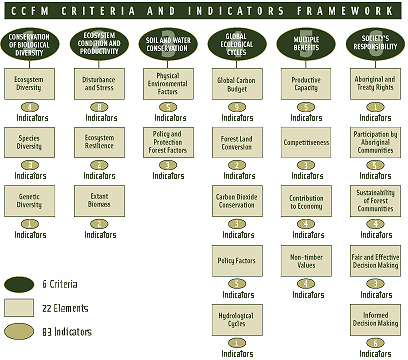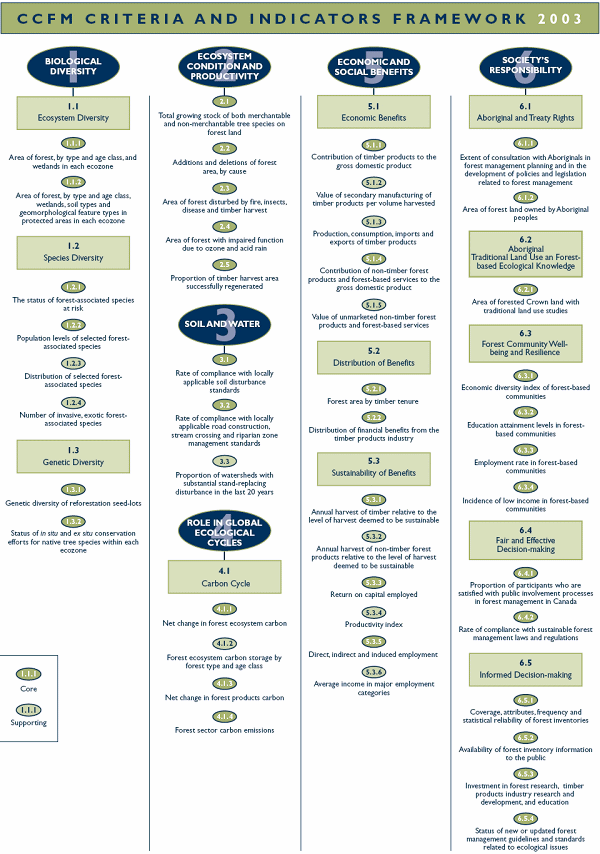|
The Canadian Standards Association certification of Sustainable Forest Management requires that the same methodology be applied as is established in the Criteria and Indicators of the Canadian Council of Forest Ministers, which is our national response to the Montreal Process, which is an international response to the United Nations Conference on Environment and Development's own Statement of Forest Principles and it's Rio Declaration. To us, the recreational users of Algonquin Park, this "daisy-chain" of worldwide authorities, agencies and standards can easily be overwhelming. For that reason, these two pages (SFM Criteria and Elements / SFM VOITS) present the crucial building-blocks of a CSA compliancy requirements for sustainable forest management plans ...2000 CCFM NATIONAL STATUS REPORT'S GRAPHIC REPRESENTATION OF CANADA'S NATIONAL C&I FRAMEWORK 
This was the CCFM C&I Framework 2000, in effect at the time that CSA Z809-02 was formulated. 2003 CCFM CRITERIA AND INDICATORS FRAMEWORK 
With the CCFM C&I Framework 2003 , while the number of Criteria remained at 6, the number of Elements was reduced from 22 to effectively 14, and the number of Indicators was reduced from 83 to 36 "Core Indicators" and 10 "Supporting Indicators". Between the original and revised CCFM C&I Frameworks, Recreation and Tourism values were relocated from 5.1.2 (Multiple Benefits to Society/Timber and Non-Timber Benefits/Recreation and Tourism) to 5.1.5 (Economic and Social Benefits/Economic Benefits/Value of Unmarketed nontimber forest products and forest-based services). It is disconcerting to read on page 98 of National Status 2005 "Further nonmarket valuation studies are needed to support this indicator". It seems that the Recreation and Tourism values of forests aren't being fully recognized anymore and have been devalued.2002 CSA Z809-02 SFM PERFORMANCE REQUIREMENTS: CCFM (pre-2002) SFM CRITERIA and CSA SFM ELEMENTS - The organization, in conformance with the public participation process requirements set out in Clause 5, shall identify DFA-specific values, objectives, indicators, and targets for each of the CSA SFM elements described in Clause 6, as well as any other values associated with the DFA. CCFM CRITERION 1 — Conservation of Biological Diversity: Conserve biological diversity by maintaining integrity, function, and diversity of living organisms and the complexes of which they are part. CSA SFM Element 1.1 Ecosystem Diversity CSA SFM Element 1.2 Species Diversity
CSA SFM Element 1.3 Genetic Diversity
CSA SFM Element 1.4 Protected Areas and Sites of Special Biological Significance CCFM CRITERION 2 — Maintenance and Enhancement of Forest Ecosystem Condition and Productivity: Conserve forest ecosystem condition and productivity by maintaining the health, vitality, and rates of biological production.
CSA SFM Element 2.1 Forest Ecosystem Resilience
CSA SFM Element 2.2 Forest Ecosystem Productivity
CCFM CRITERION 3 — Conservation of Soil and Water Resources
CSA SFM Element 3.1 Soil Quality and Quantity
CSA SFM Element 3.2 Water Quality and Quantity
CCFM CRITERION 4 — Forest Ecosystem Contributions to Global Ecological Cycles
CSA SFM Element 4.1 Carbon Uptake and Storage
CSA SFM Element 4.2 Forest Land Conversion
CCFM CRITERION 5 — Multiple Benefits to Society
CSA SFM Element 5.1 Timber and Non-Timber Benefits
CSA SFM Element 5.2 Communities and Sustainability
CSA SFM Element 5.3 Fair Distribution of Benefits and Costs
CCFM CRITERION 6 — Accepting Society’s Responsibility for Sustainable Development
CSA SFM Element 6.1 Aboriginal and Treaty Rights
CSA SFM Element 6.2 Respect for Aboriginal Forest Values, Knowledge, and Uses
CSA SFM Element 6.3 Public Participation
CSA SFM Element 6.4 Information for Decision-Making It is important to note that subsequent to the CSA's publishing of CSA Z809-02, the CCFM published it's greatly revised Criteria and Indicators Framework 2003. As a result, while CSA's Z809-02 does represent the SFM standards of the end of the century, the CCFM organization appears to be committed to continuously revising their versions of the standards. Standards associations may not wish to follow suite. And, even if they should, provincial and private forestry operators may not be able to afford such repeated system-wide revisions to their SFM plans. |